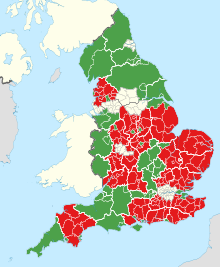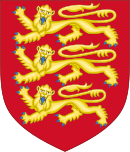| Non-metropolitan district | |
|---|---|
| |
 | |
| Category | Local authority districts |
| Location | England |
| Found in | Non-metropolitan county |
| Created by | Local Government Act 1972 |
| Created |
|
| Number | 226 (as of 2023) |
| Possible types |
|
| Possible status | |
| This article is part of a series within the Politics of the United Kingdom on the |
| Politics of England |
|---|
 |
|
The Crown
|
| Governance |
|
Legislative
|
ElectionsUK General Elections in England
|
| Judiciary |
| Regions |
| Administration |
Non-metropolitan districts, or colloquially "shire districts", are a type of local government district in England. As created, they are sub-divisions of non-metropolitan counties (colloquially shire counties) in a two-tier arrangement. Non-metropolitan districts with borough status are known as boroughs, able to appoint a mayor and refer to itself as a borough council. Some shire counties, for example Cornwall, now have no sub-divisions so are a single non-metropolitan district.
Typically, a district will consist of a market town and its more rural hinterland. However, districts are diverse, with some being mostly urban (such as Dartford) and others more polycentric (such as Thurrock).
Structure
Non-metropolitan districts are subdivisions of English non-metropolitan counties which have a two-tier structure of local government. Two-tier non-metropolitan counties have a county council and several districts, each with a borough or district council. In these cases local government functions are divided between county and district councils, to the level where they can be practised most efficiently:
- Borough/district councils are responsible for local planning and building control, council housing, environmental health, markets and fairs, refuse collection and recycling, cemeteries and crematoria, leisure services, parks, and tourism.
- County councils are responsible for running the largest and most expensive local services such as education, social services, libraries, main roads, public transport, fire services, Trading Standards, waste disposal and strategic planning.
- In the case where a non-metropolitan county consists of a single non-metropolitan district, there is a single council, a unitary authority, that is responsible for all functions.
| Service | Non-metropolitan county | Non-metropolitan district | Unitary authority |
|---|---|---|---|
| Education | |||
| Housing | |||
| Planning applications | |||
| Strategic planning | |||
| Transport planning | |||
| Passenger transport | |||
| Highways | |||
| Fire | |||
| Social services | |||
| Libraries | |||
| Leisure and recreation | |||
| Waste collection | |||
| Waste disposal | |||
| Environmental health | |||
| Revenue collection |
Status
Many districts have borough status, which means the local council is called a borough council instead of district council and gives them the right to appoint a mayor. Borough status is granted by royal charter and, in many cases, continues a style enjoyed by a predecessor authority, which can date back centuries. Some districts such as Oxford or Exeter have city status, granted by letters patent, but this does not give the local council any extra powers other than the right to call itself a city council.
History
By 1899, England had been divided at district level into rural districts, urban districts, municipal boroughs, county boroughs and metropolitan boroughs. This system was abolished by the London Government Act 1963 and the Local Government Act 1972. Non-metropolitan districts were created by this act in 1974 when England outside Greater London was divided into metropolitan counties and non-metropolitan counties. Metropolitan counties were sub-divided into metropolitan districts and the non-metropolitan counties were sub-divided into non-metropolitan districts. The metropolitan districts had more powers than their non-metropolitan counterparts. Initially, there were 296 non-metropolitan districts in the two-tier structure, but reforms in the 1990s and 2009 reduced their number to 192. A further 55 non-metropolitan districts are now unitary authorities, which combine the functions of county and borough/district councils.
Scotland and Wales
In Wales, an almost identical two-tier system of local government existed between 1974 and 1996 (see Districts of Wales). In 1996, this was abolished and replaced with an entirely unitary system of local government, with one level of local government responsible for all local services. Since the areas for Wales and England had been enacted separately and there were no Welsh metropolitan areas, the term 'non-metropolitan district' does not apply to Wales. A similar system existed in Scotland, which in 1975 was divided into regions and districts, this was also abolished in 1996 and replaced with a fully unitary system.
District Councils' Network
In England most of the district councils are represented by the District Councils' Network, special interest group which sits within the Local Government Association. The network's purpose is to "act as an informed and representative advocate for districts to government and other national bodies, based on their unique position to deliver for local people."
List of counties and districts
This is a list of two-tier non-metropolitan counties and their districts. All unitary authorities are also non-metropolitan districts, which, with the exception of those of Berkshire, are coterminous with non-metropolitan counties.
For a full list of districts of all types including unitary authorities, metropolitan districts and London boroughs, see Districts of England.
List of abolished non-metropolitan districts
This is a list of former two-tier districts in England which have been abolished, by local government reorganisations such as the 2009 structural changes to local government in England. It does not include districts that still exist after becoming a unitary authority or those that transferred from one county to another, including those that changed name. Nor does it include unitary authorities that have been abolished (Bournemouth and Poole).
See also
- List of local governments in the United Kingdom
- District Councils' Network
- 2019–2023 structural changes to local government in England
Notes
- the district was abolished in 1996 and merged to form a larger York unitary district
References
- "A Beginners Guide to UK Geography (2023)". Open Geography Portal. Office for National Statistics. 24 August 2023. Retrieved 9 December 2023.
The 188 non-metropolitan districts (also known as local authority districts (LAD)) form the lower tier of the two-tier local government structure found in many parts of England. They are subdivisions of the non-metropolitan (shire) counties.
- National Statistics – Counties, Non-metropolitan Districts and Unitary Authorities Archived 9 May 2002 at the UK Government Web Archive
- "Members | District Councils' Network". Districtcouncils.info. Retrieved 24 September 2013.
- "Special interest groups | Local Government Association". Government of the United Kingdom. 30 August 2013. Retrieved 24 September 2013.
External links
| Region | |
|---|---|
| County | |
| District and civil parish | |